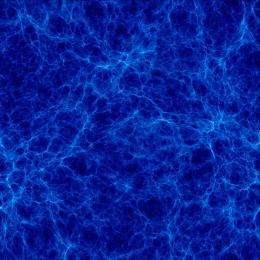Cosmological evolution of dark matter is similar to that of visible matter

High-resolution computer simulations prepared by a team of scientists from the Faculty of Physics, University of Warsaw (FUW), the Lebedev Physical Institute of the Russian Academy of Sciences and the Institute for Astrophysics in Potsdam made it possible to trace the evolution of large clouds of dark and normal matter that fill the Universe. The results confirm earlier assumptions regarding the basic features of dark matter, especially its distribution on cosmological scales.
For several decades, astronomers have been struggling to explain the motion of stars in galaxies and of galaxies in galaxy clusters. Measurements show that a typical galaxy must contain 10 to 50 times more invisible matter than normal one, and galaxy clusters must contain even up to 100 to 500 times more of the former. “It turns out that normal matter, which makes up our everyday world, is but a slight addition to dark matter. There is at least six times more of the latter in the Universe – and nobody knows what it is. Discovering its nature is a thrilling experience,” says Prof. Marek Demiański from the Faculty of Physics, University of Warsaw (FUW).
Nowadays it is assumed that dark matter consists of exotic particles, not yet known to science, which barely, if at all, interact with electromagnetic radiation and other elementary particles known today. Scientists can observe dark matter only indirectly, by investigating the impact of its gravity on the motion of normal matter. Given the significant amount of dark matter, it must have played a fundamental role in the formation of galaxies and their clusters.
Scientists are, therefore, interested in the way in which dark matter is distributed across the Universe and in which the structures made up of it evolved over time. In order to answer these questions, one would need to observe galaxy clusters, the light of which travelled to Earth ten or more billion years. Yet such distant object are difficult to detect. As a result, the amount of observational data is insufficient to allow for a statistical analysis.
Computer simulations prove useful in research into dark matter. They make it possible to observe the process of clustering of dark matter on large scales and its impact on the distribution of normal matter. By comparing the results obtained in this way with observational data, it is possible to assess the extent to which the scientists’ assumptions regarding the properties of dark matter coincide with the reality.
In the early periods after the Big Bang both dark and normal matter were more or less equally distributed. In contrast to normal one, dark matter does not interact with electromagnetic radiation, which filled the Universe shortly after the Big Bang and thus could succumb more quickly to the impact of its own gravity. Slight distortions in the distribution of dark matter began to contract gravitationally, attracting dark matter, and in later periods also normal one. The simulations by Polish, German and Russian group of scientists mirror the process.
During the simulations the scientists analyzed the behaviour of about a billion point objects distributed in a cube with side length of several hundred million light years. As time went on, the original cube was expanded along with the “ballooning” Universe. About a billion points were evenly distributed in the cube – the limitation on their number being the computing power of today’s computers. Each point in the simulation had a mass of hundred million times the mass of the Sun. Characteristics of dark matter were assigned to most of the points. Subsequently, the scientists analyzed the way in which the distribution of the points was changing over time under the influence of gravity.
One of the most important conclusions emerging from the performed simulations is the confirmation of the self-similarity of the process of evolution of the structure of dark and normal matter on large cosmic scales. Which means that if we examine a cube four billion years after the Big Bang and later compare it with a ten-billion-year-old cube, then, after matching the dimensions of both cubes, it turns out that the structures inside them made up of dark and normal matter look virtually the same.
“This similarity between the processes of evolution of both types of matter makes it possible to recreate the distribution of dark matter on the basis of the distribution of normal matter. Our simulations have confirmed this effect and we can now say with greater certainty that we are able to gain insight into the invisible world of dark matter by observing the motion of galaxy clusters,” concludes Prof. Demiański.
The results of the computer simulations of the distribution of dark and normal matter were published in the “Monthly Notices of the Royal Astronomical Society” journal and presented on the international conference “JENAM 2011 European Week of Astronomy and Space Science” on July 4-8 in Saint Petersburg, Russia.
Provided by University of Warsaw



















